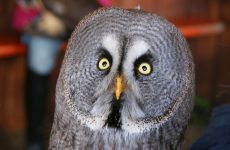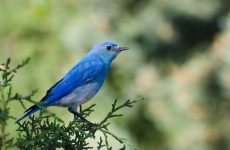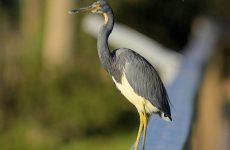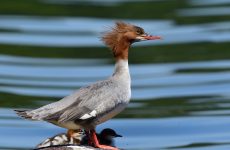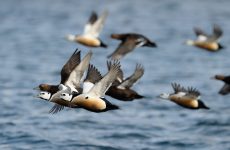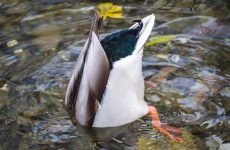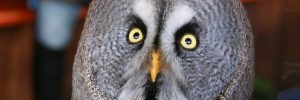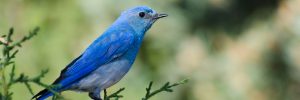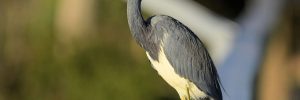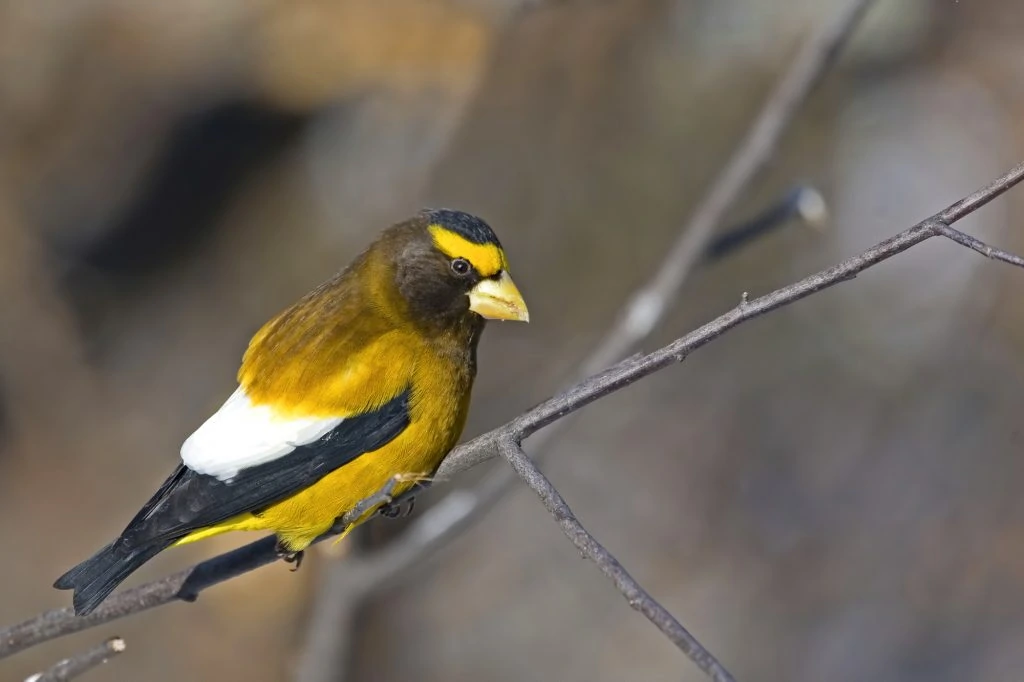
Grosbeak literally means ‘large beak’ and is given to songbirds from three different families: finches, cardinals, and weavers.
There are a total of 34 species of Grosbeaks in the world, and of these, five are regularly occurring, and two are casual visitors to North America. The Grosbeaks in North America are from the finch and cardinal families.
Male Grosbeaks are brightly colored sturdy birds, and females are more subdued in their coloring. They have powerful beaks suitable for cracking seeds and notched tails and look very similar in size and shape even though they are from different family groups.
Black-headed Grosbeaks live to the west of the Rockies, and Rose-breasted Grosbeaks live to the east. Blue Grosbeaks live in the Great Plains and southern states.
Evening Grosbeaks, although they are one of the most famous of the North American breeds, may just suddenly appear from time to time when cone crops are bad, and they have to fly south to feed. Usually, they live in Canada and west of the Rockies.
Pine Grosbeaks are usually found in similar areas to Evening Grosbeaks. The other two species are accidental and usually live further south in Mexico and beyond, but they stray across the border.
This guide will help you identify the types of Grosbeaks spotted in North America according to avibase and uses data collected from bird watchers on ebird to give real information about when and how often these birds are spotted. The birds are ordered in how frequently they are recorded on checklists by bird watchers.
How often Grosbeak are recorded in bird checklists in North America:
- Rose-breasted Grosbeak 3.00%
- Black-headed Grosbeak 1.80%
- Blue Grosbeak 1.50%
- Evening Grosbeak 0.57%
- Pine Grosbeak 0.17%
- Crimson-collared Grosbeak >0.01% – accidental
- Yellow Grosbeak >0.01% – accidental
7 Species of Grosbeak in North America:
1. Rose-breasted Grosbeak
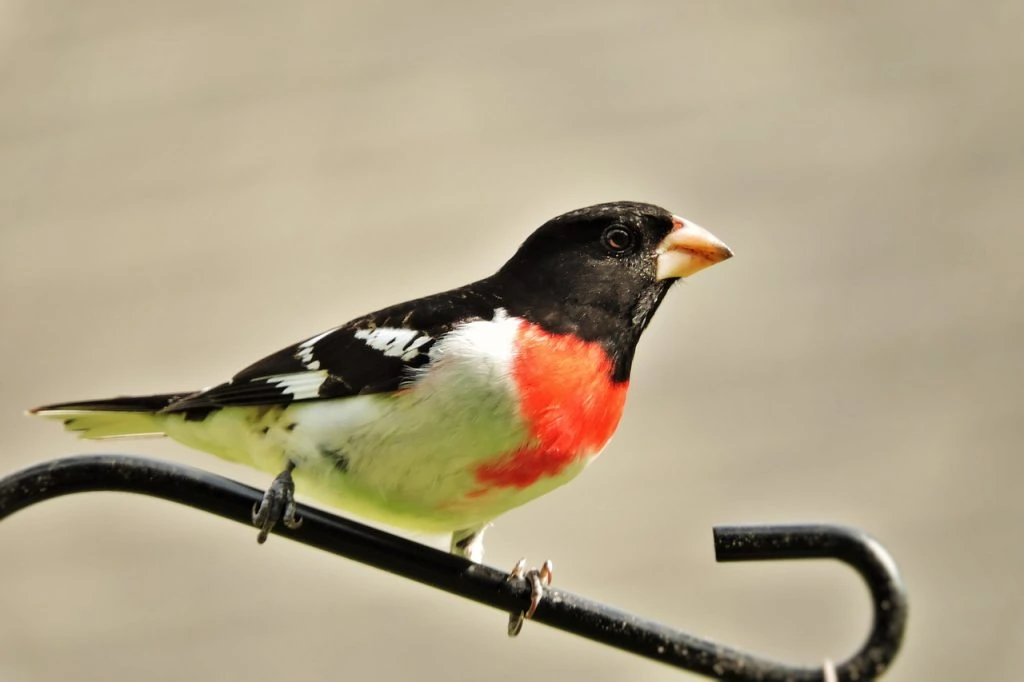
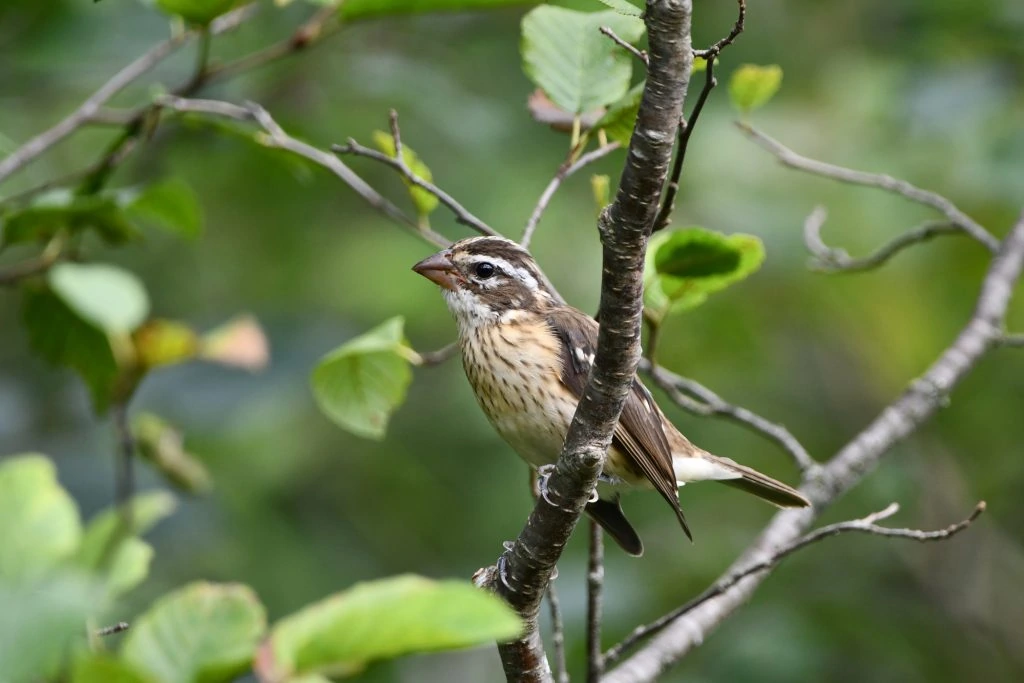
Rose-breasted Grosbeaks males are black-and-white birds with black heads and backs, white bellies, and red breasts. They also have a flash of red under their wings.
Female Rose-breasted Grosbeaks and immature males are brown with lots of streaking and a flash of yellow under the wings.
- Pheucticus ludovicianus
- Length: 7.1-8.3 in (18-21 cm)
- Weight: 1.4-1.7 oz (39-49 g)
- Wingspan: 11.4-13.0 in (29-33 cm)
Rose-breasted Grosbeaks breed in northeastern US states, the Midwest, and southern and central Canada. They can be seen during migration in southeastern US states. Winter is spent in Mexico, Central America, and the Caribbean.
You can find Rose-breasted Grosbeaks in forests, parks, and backyards foraging for insects, berries, and seeds.
Rose-breasted Grosbeaks Song:
Nests of Rose-breasted Grosbeaks are placed in the branches of a low tree. They are made of loosely-formed twigs, grass, and plants. There are about five eggs that take two weeks to hatch. Both parents take turns incubating the eggs.
Attract Rose-breasted Grosbeaks to your backyard with sunflower seeds and peanuts.
Fun Fact: Unlike most songbirds, the female Rose-breasted Grosbeak is known to sing as well.
2. Black-headed Grosbeak
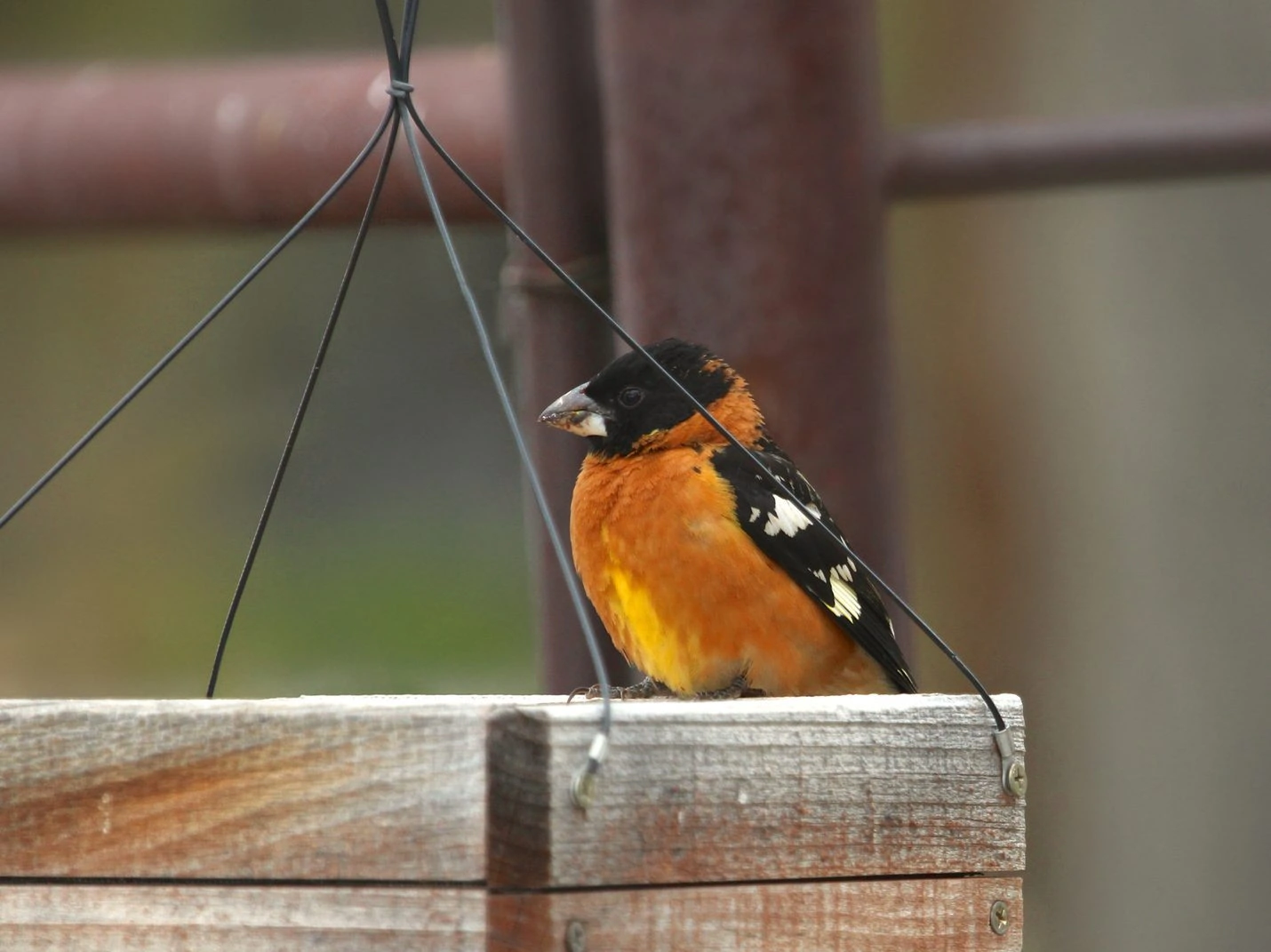
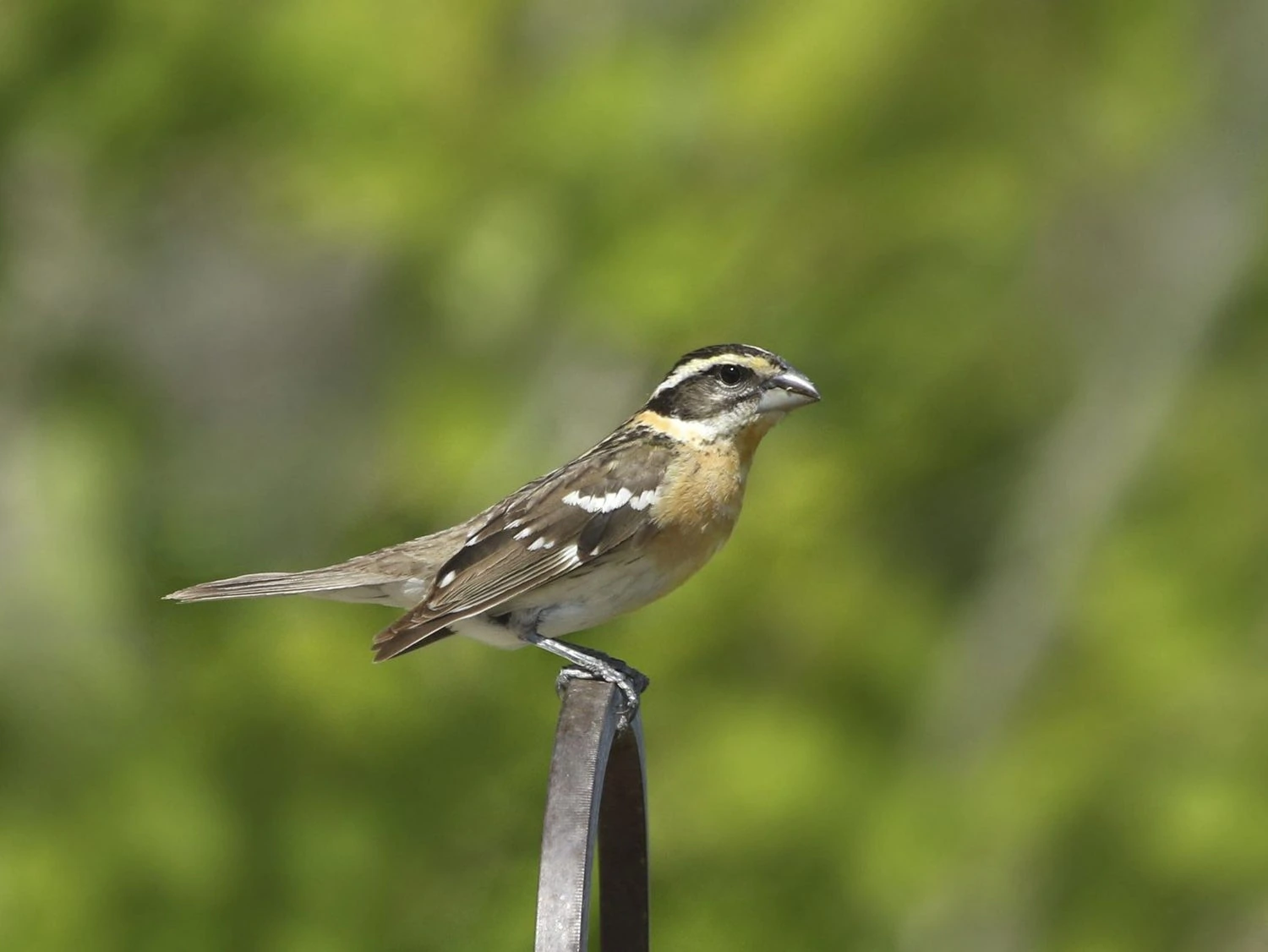
Black-headed Grosbeaks are large songbirds with orange breasts and throats and black wings and heads. Females are brown on the back and with brown spots on their pale orange breasts.
- Pheucticus melanocephalus
- Length: 7.1-7.5 in (18-19 cm)
- Weight: 1.2-1.7 oz (35-49 g)
- Wingspan: 12.6 in (32 cm)
Black-headed Grosbeaks breed west of the Rockies and migrate to Mexico for the winter.
You can find Black-headed Grosbeaks in habitats with access to water, and they often visit backyards. Their large bills are great for crushing seeds and insects such as snails and beetles.
Black-headed Grosbeak Song:
Nests of Black-headed Grosbeaks are made from twigs, pine needles, and other plant material. They are loosely made but lined with softer material, including hair and stems. They lay up to five eggs, which take two weeks to hatch and up to two weeks for the young to leave the nest.
Attract Black-headed Grosbeaks to your backyard with sunflower seed feeders. They will also feed on oriole feeders.
Fun fact: Male Black-headed Grosbeaks court the females by singing while fluttering up and down from a perch with their wings spread to display their coloring.
3. Blue Grosbeak
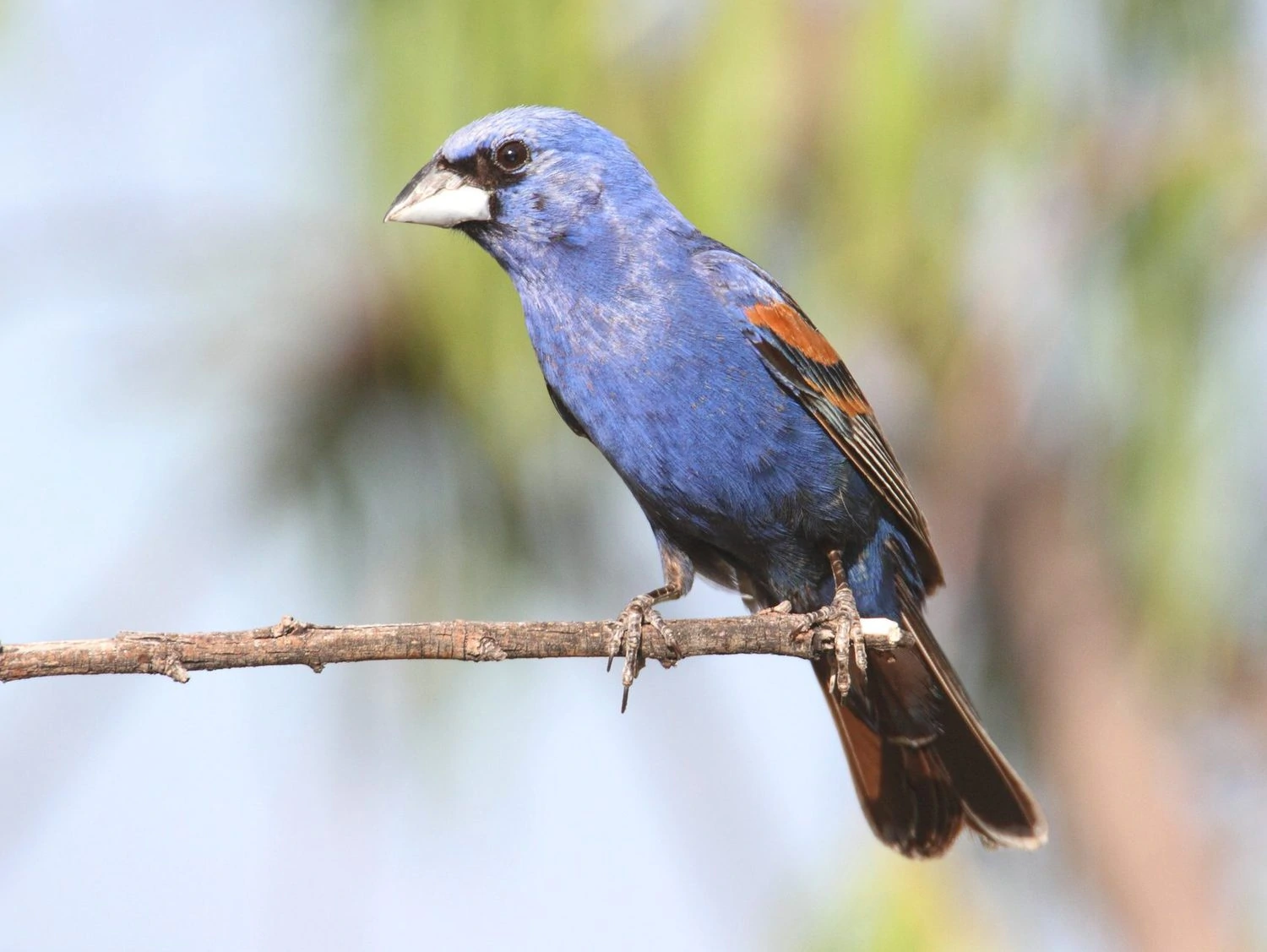
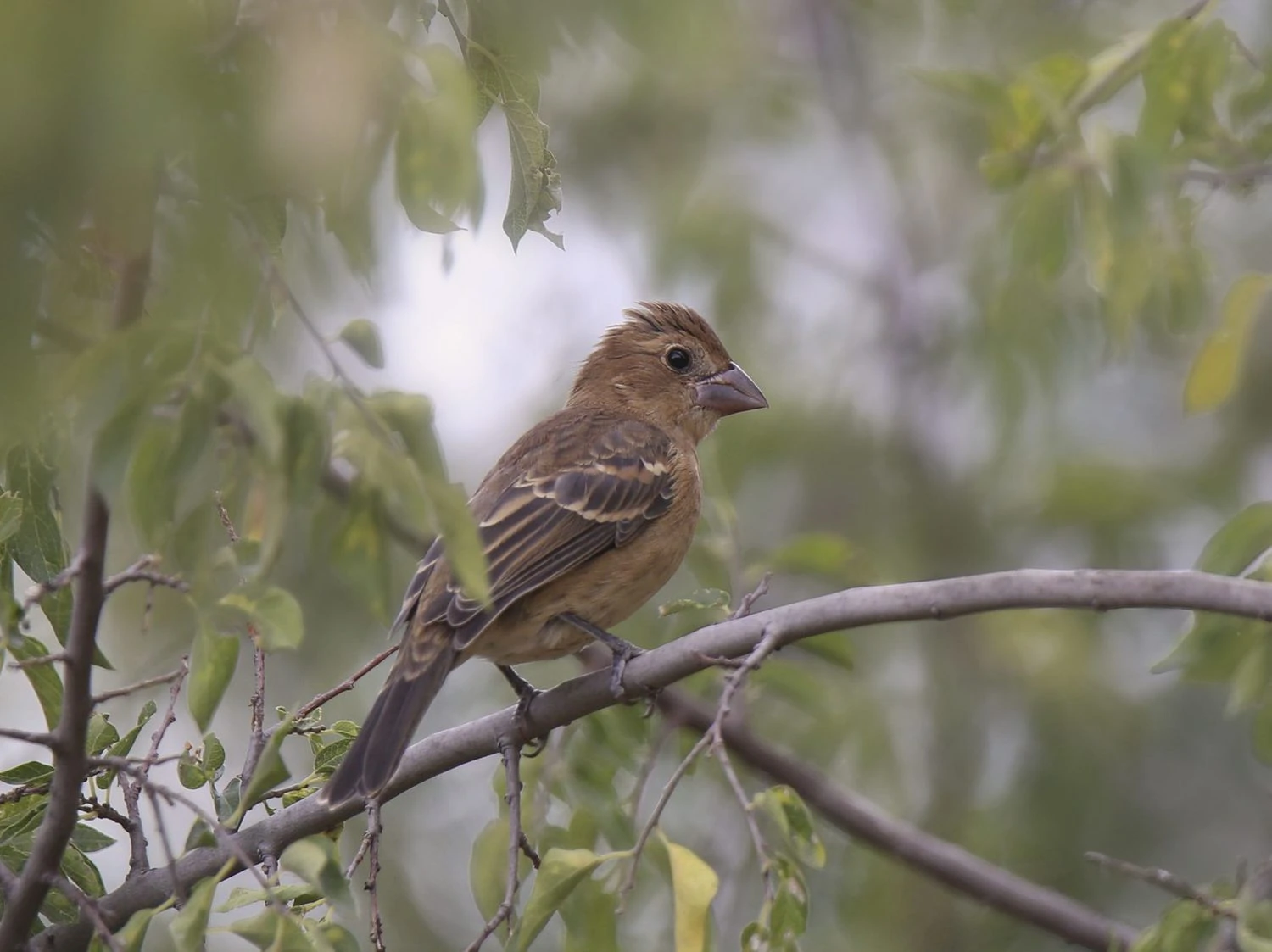
Blue Grosbeaks are medium-sized birds with large bills. Males are blue with two brown wing bars. Females are mostly brown but with some blue coloring on their bodies. They share the same brown wing bars as the male. Juvenile males are covered in patchy blue-cinnamon feathers with brown wing bars.
- Passerina caerulea
- Length: 5.9-6.3 in (15-16 cm)
- Weight: 0.9-1.1 oz (26-31 g)
- Wingspan: 11.0 in (28 cm)
Blue Grosbeaks breed in southern US states and the Great Plains before migrating to Mexico, Central America, and the Caribbean.
You can find the Blue Grosbeak in shrubby habitats. They prefer semi-open areas with cultivated lands, overgrown fields, woodland edges, or hedgerows.
Blue Grosbeaks diet is insects and seeds. During the summer, they feast on caterpillars, praying mantises, grasshoppers, and beetles, as well as spiders and snails. They also eat seeds, weeds, and grass too. In winter, they eat mainly seeds.
Blue Grosbeak Song:
Nests of Blue Grosbeaks can be found low in the ground, around shrubs and vines. They usually are found up to ten feet above the ground and built from twigs, weeds, leaves, and bark. The inside is lined with snakeskin, paper, fine grass, and animal hair. They lay up to five eggs that take about ten days to hatch. In another ten days, the young leave the nest.
Attract Blue Grosbeaks to your yard with grain and seeds.
Fun fact: Breeding pairs of Blue Grosbeaks may defend a territory of up to 20 acres.
4. Evening Grosbeak
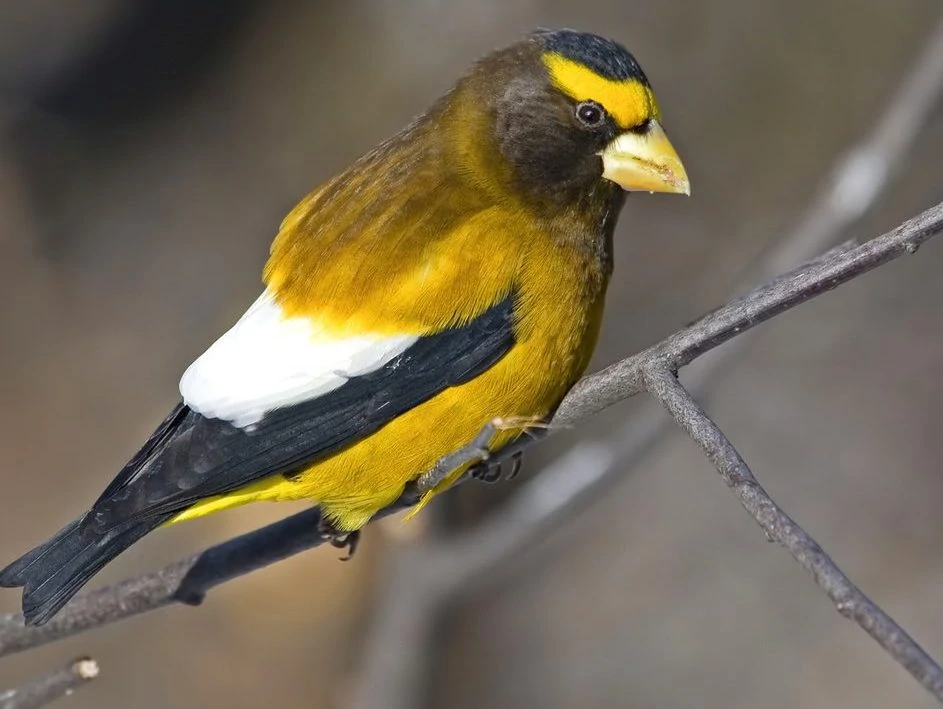
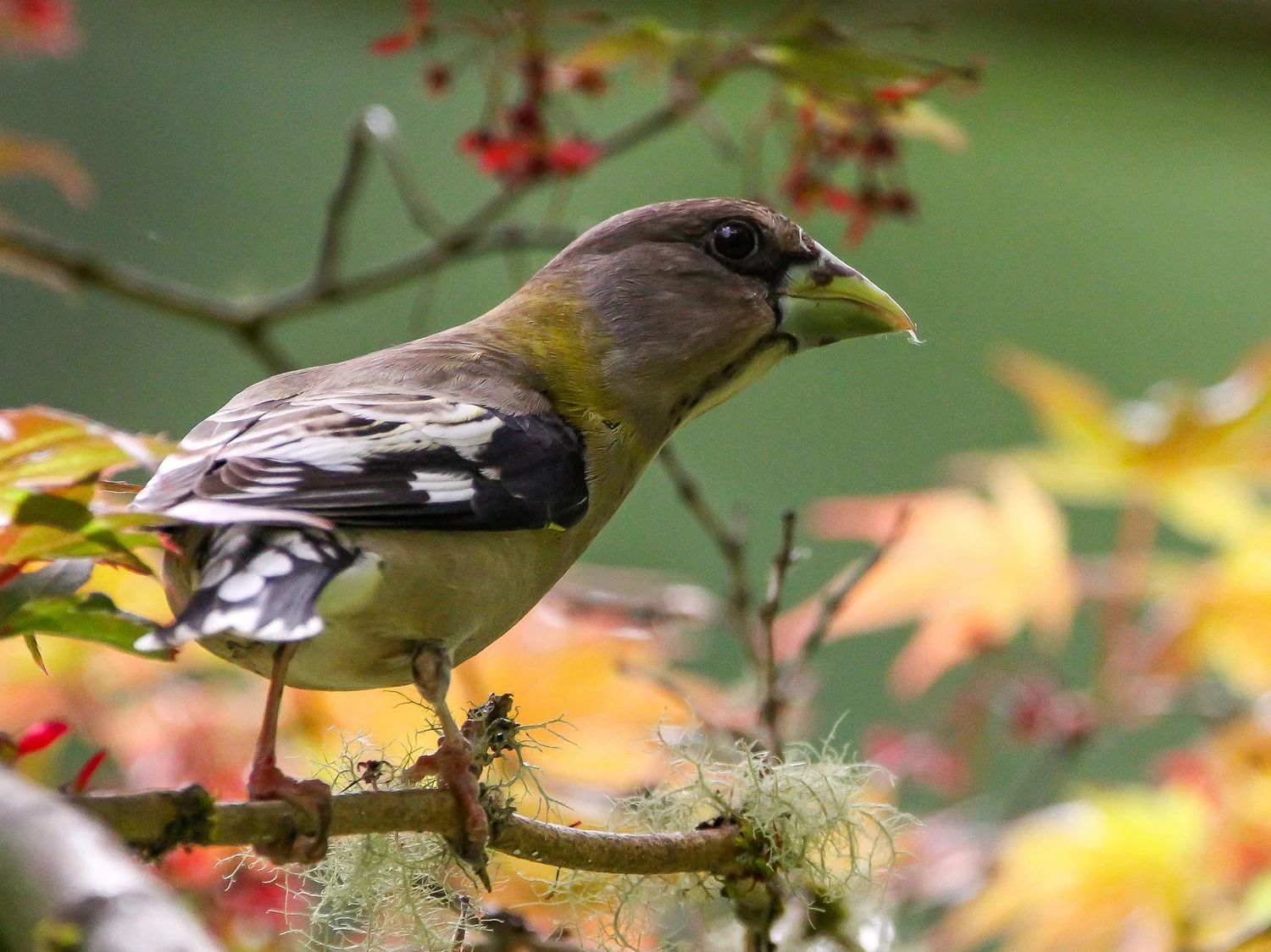
Evening Grosbeaks are chunky birds with big bills and a striking yellow and black pattern. Adult males have a bright yellow stripe over their eyes, making them look fierce. Their heads are black, with gray necks, and their chest and belly are yellow. They also have a white patch on their wings.
Females and juvenile males have greenish bills, mostly gray bodies, black and white wings, and a yellow tinge to the neck.
- Hesperiphona vespertina
- Length: 16 to 22 cm (6.3 to 8.7 in)
- Weight: 38.7 to 86.1 g (1.37 to 3.04 oz)
- Wingspan: 30 to 36 cm (12 to 14 in)
Evening Grosbeaks remain all year in southern Canada and down the west coast to northern California. However, when cone crops are poor, they will migrate south to most US states.
You can find Evening Grosbeaks in forests and mountain regions. They’re often attracted to bird feeders in backyards during the winter, most often because it’s an easy food supply.
Evening Grosbeaks naturally feed on flower buds during spring; insect larvae from treetops during the summer; and in the winter, they flock to backyard feeders or feast on seeds, berries, and small fruit.
Evening Grosbeak Song:
Nests of Evening Grosbeaks are usually found up to 100 feet above ground in pine trees. The nests are loosely made, composed of twigs, rootlets, grass, moss, and pine needles. There are usually up to five eggs laid by the female, and she incubates them for two weeks until they hatch.
Attract Evening Grosbeaks to your backyard during winter with sunflower seeds, berries, and maple buds.
Fun fact: Evening Grosbeaks have such powerful bills that they can crush seeds that are too hard to open for other smaller birds, so these birds hang around to eat whatever is left behind.
5. Pine Grosbeak
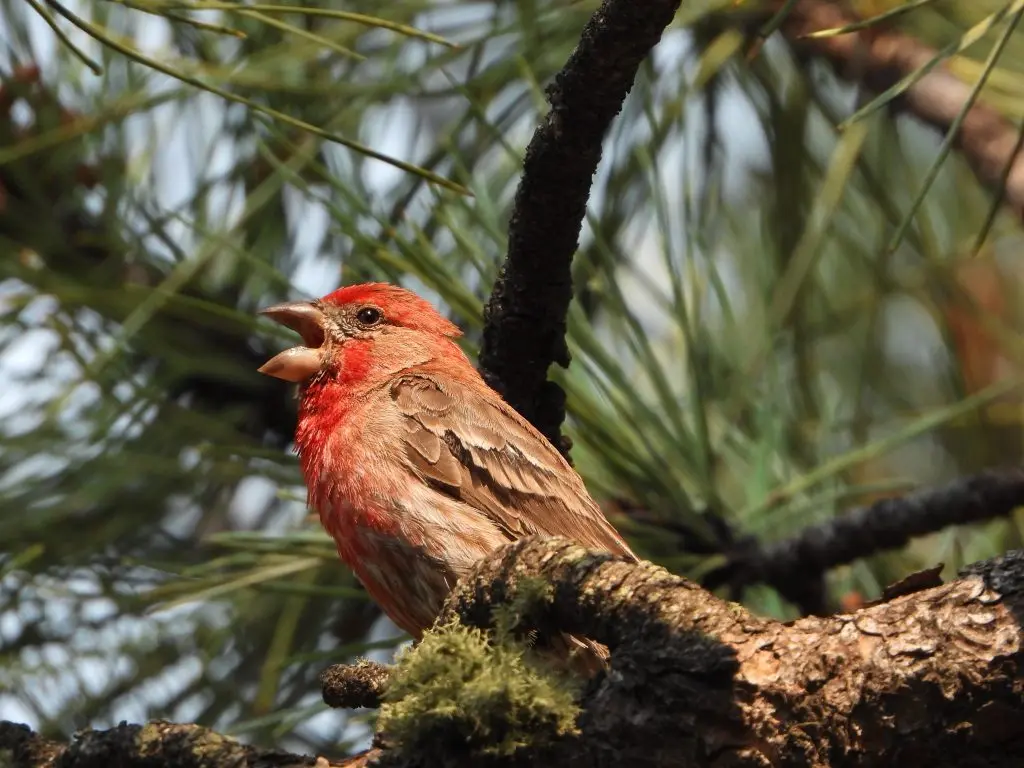
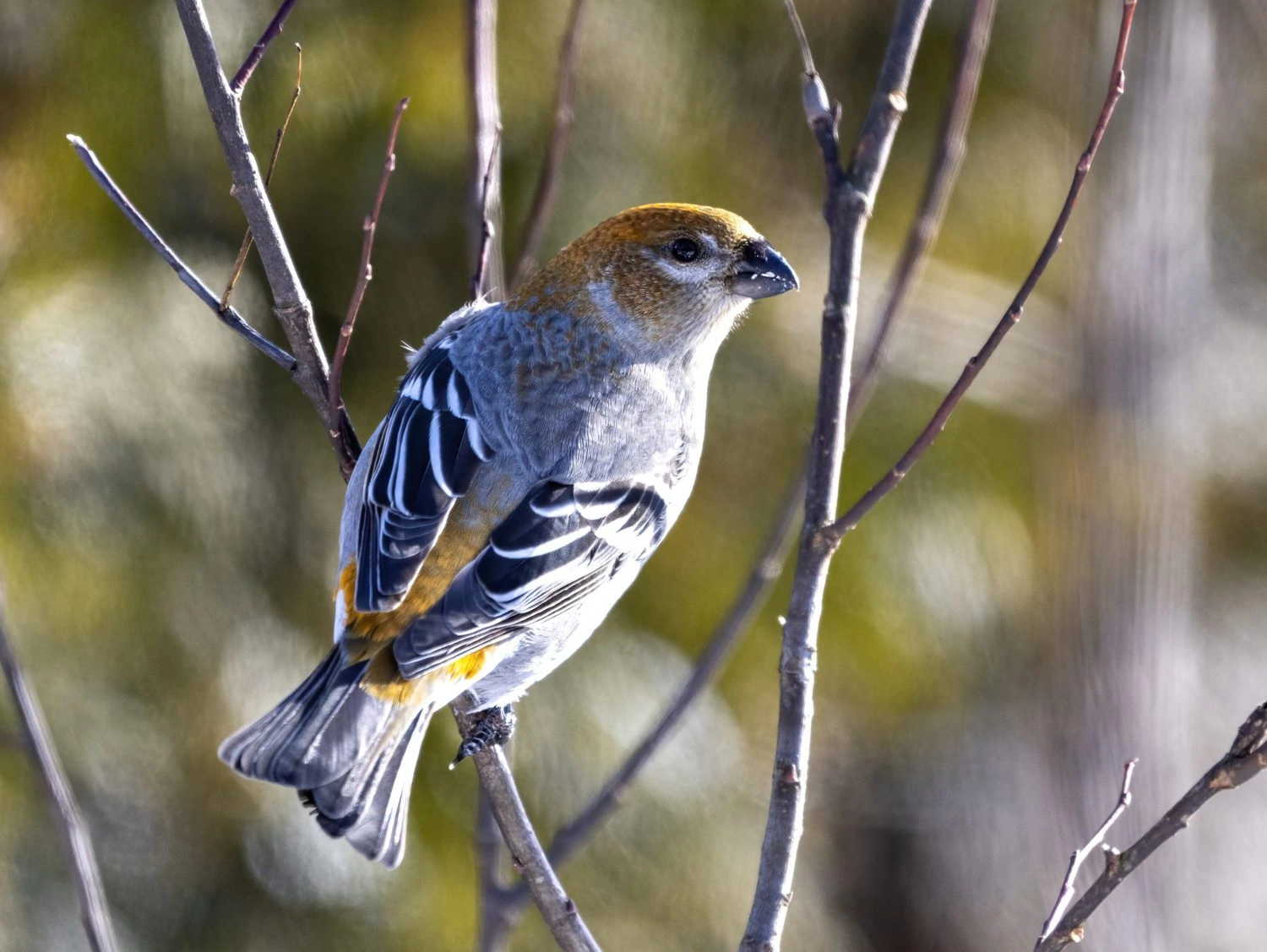
Pine Grosbeaks males are red birds with gray on the wings and tail and two white wingbars. Females are gray with dull orange heads and rumps. They are large for finches and relatively slow.
- Pinicola enucleator
- Length: 7.9-9.8 in (20-25 cm)
- Weight: 2.01 oz (57 g)
- Wingspan: 13.0 in (33 cm)
Pine Grosbeaks are mostly found in Canada, but some can be spotted along the US border, the mountainous west, and the Sierra Nevada in California.
You can find Pine Grosbeaks in forests of pine, spruce, and fir, feeding on seeds, fruit, and buds from these trees. They will also eat some insects in the summer.
Pine Grosbeak Call:
Nests of Pine Grosbeaks are commonly found ten to twelve feet above the ground on a low tree. The nests are made of twigs, barks, weeds, moss, and lichen and hold two to five eggs. The female incubates these eggs for about two weeks until they hatch.
Attract Pine Grosbeaks to your backyards with black oil sunflower seed feeders or suet feeders.
Fun Fact: Pine Grosbeaks are aptly named. Their scientific name, “Pinicola,” is Latin for “pine dweller”.
6. Crimson-collared Grosbeak
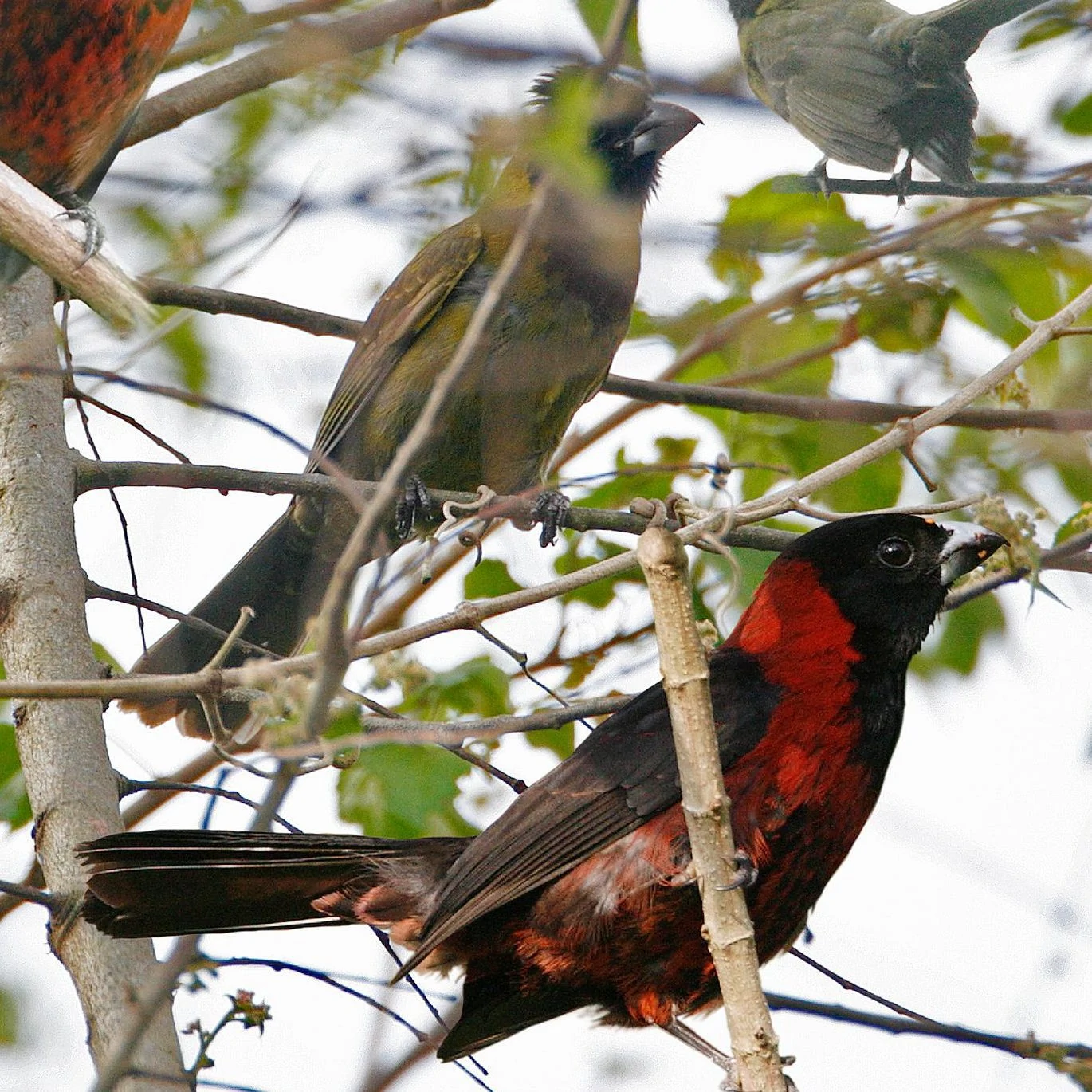
Crimson-collared Grosbeaks are medium-sized, stocky birds from the cardinal family. The male is remarkably striking with its black hood and bright crimson, sometimes pinkish-red collar and shoulders. Its belly is dotted with black. The female also has a black hood but has a greenish/yellowish body.
- Rhodothraupis celaeno
- Length: 8.0 – 9.25 inches (20.2 – 23.5 cm)
- Weight: 2.1 oz (60g)
Crimson-collard Grosbeaks live in northeastern Mexico, and they sometimes wander up to southern Texas.
You can find Crimson-collared Grosbeaks in humid or semi-dry forested areas, woodland edges, and dense, brushy thickets.
It is hard to know precisely what the Crimson-collared Grosbeak eats as it keeps itself hidden under dense cover when foraging. However, it probably feeds on fruits and berries, leaves, and insects.
Crimson-collard Grosbeak Song:
Nests of Crimson-collared Grosbeaks are made out of grasses and twigs, usually built on a bush, shrub, or low tree. They lay three eggs, but not much else is known about their young.
7. Yellow Grosbeak
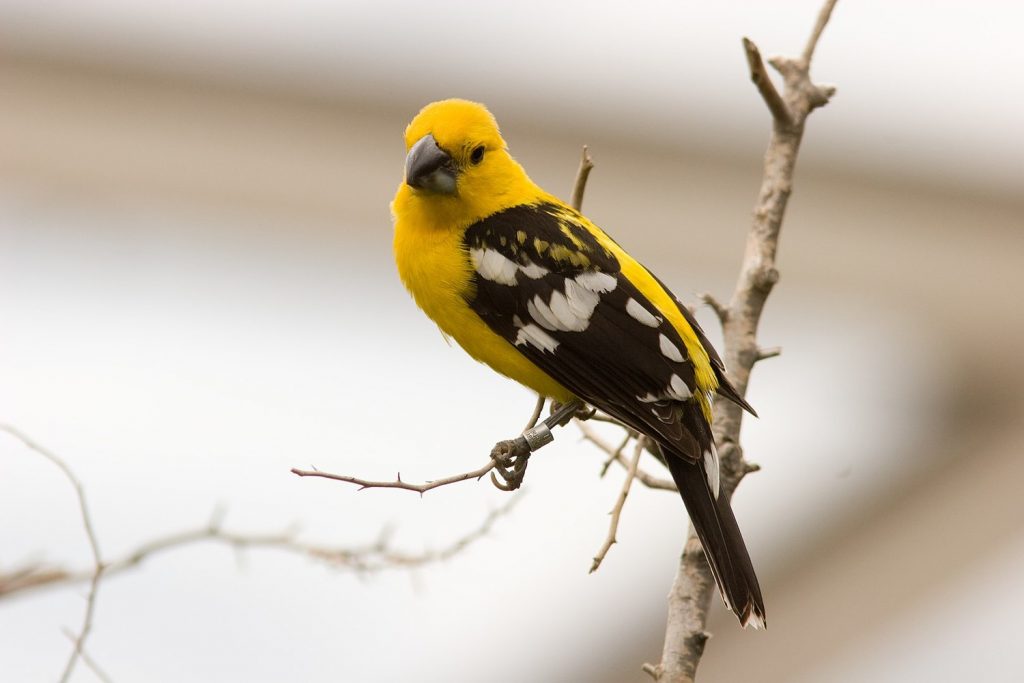
Yellow Grosbeaks are medium-sized birds from the cardinal family with gray-black bills that seem too big for their bodies. The male’s head, chest, and belly are a bright, solid yellow, with black wings dotted with white markings.
Females have a more subdued color, sometimes even olive-hued on the head and the rest of the body, while the wings are gray with white tips.
- Pheucticus chrysopeplus
- Length: 8.5 – 9.4 inches (21.5 – 24 cm)
- Weight: 2.2 oz (62g)
Yellow Grosbeaks live on the Pacific side of Mexico and into southern US states.
You can find the Yellow Grosbeak in tropical forests, woodlands, and shade-coffee plantations feeding on seeds, fruits, and berries. They also feast on insects.
Nests of Yellow Grosbeaks are commonly built on mid-level trees or in dense bushes. They are made using grass and sticks with other fine materials lining them. The female lays around five eggs that incubate for about two weeks.
Attract Yellow Grosbeaks to your background by leaving sunflower seeds, apple slices, and peanut kernels in your bird feeders.

